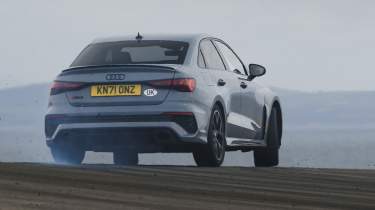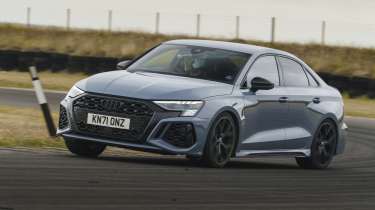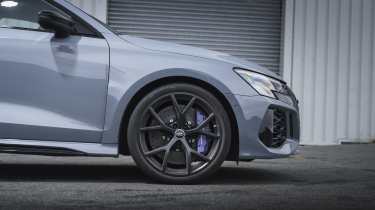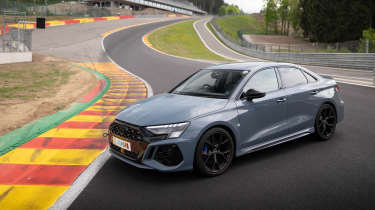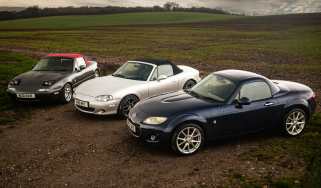Audi RS3 Saloon Fast Fleet test – 12,000 miles in the five-cylinder hot hatch
Its wheels rarely stopped turning and its appeal grew with every mile, but now it’s time to say goodbye
The RS3 has gone. It left with nearly 17,000 miles covered, including two trips to Spa and another to the Nürburgring. During our time together it was the star of a group test (evo 295) and a further big track-focused feature (299) and, as the miles accrued, it gained that reassuring feeling that a car exudes when it becomes a part of the family. I can’t remember such a hard-worked long-term test car.
Things didn’t start brilliantly. Against the might of the BMW M4 Competition xDrive on a filthy, bitterly cold test up on the Scottish Borders, the RS3 felt like it was trying too hard and the trick clutch-actuated torque-vectoring rear diff created extreme agility but not as much confidence as we expected. It’s a stunningly powerful tool in reducing understeer but seemed to make the RS3 inconsistent on roads streaming with water, mulch and mud. The price of entry (£55,405 basic, almost £69,000 as tested) cast a shadow from which the RS3 struggled to emerge.
> Audi RS e-tron GT Fast Fleet test – 6 months in the 637bhp electric saloon
Yet over time, Audi’s wild little saloon wormed its way into our affections. So much of what it represents is right. It’s compact in a world of bloaters; the 2.5-litre five-cylinder engine has character in abundance; the chassis is supple even over nasty surfaces and there’s a sense of durability and enthusiasm in everything that it does. Unlike so many cars, the RS3 feels special even at low speeds. And – my favourite bit of all – on every single journey it conjures up a moment or two of real joy. The RS3 might not be a natural group-test winner, but it’s a pretty compelling package on a day-to-day basis.
More reviews
Group tests
In-depth reviews
Reviews
So the good stuff is very good and even the ‘faults’ can make for entertainment, too. The engine, for example, doesn’t have the ultra-responsive feel of, say, the four-cylinder motor in the Golf R. Yet it’s so much more dramatic once on boost and feels bigger, angrier and more bespoke. It really is the heart of the car. Nearly 400bhp works the chassis hard, too.
Dynamically the RS3 really is an interesting car to drive. The big surprise is the unbelievable resistance to understeer. Open the bonnet and you can see the engine is slung out ahead of the front wheels, but you’d never know it. Like many Audis of old the front-to-rear torque split will only go to 50:50, but the RS Torque Splitter differential can send all of the rear axle’s share to the outside-rear wheel, giving a much more neutral balance and the illusion that the bias is much more rearward. The result is pinpoint agility and an almost rear-drive balance at times, but married to supreme traction. The RS3 really bites into the road.
So the RS3 turns in hard and as you apply the throttle the car will start to oversteer. However, such is the grip and the peculiarities of the torque split and active rear differential, what happens next can feel very frantic indeed. Essentially the rear axle is trying to create a yaw angle, whilst the front wheels are pulling the car rapidly straight. Add to this a high level of grip and the transition from grip to slip and back to grip can feel extremely abrupt. Funnily enough, this makes the RS3 quite an edgy experience when driven hard on the road. Then throw in the rear diff’s changeable behaviour at different speeds and the RS3 can feel magical one minute and frantic the next. You could never accuse it of being dull…
One big option worth discussion is the fitment of ceramic brakes (part of the RS Dynamic Pack). I love the absurdity of having a small performance saloon car with ceramics but, on balance, I don’t think they’re a great fit for the car. Or perhaps the application is just flawed. Firstly, I found them slightly unnerving on motorway drives in the wet, where long periods of inactivity would be followed by a momentary delay in response as the discs dried but didn’t actually do much in the way of stopping. We’re talking a heartbeat of delay, but at motorway speeds that’s enough to induce a moment of runaway panic.
Conversely, in more dynamic road driving the ceramics are strong and completely tireless but the initial bite is too grabby. In a car that can struggle to truly flow for the reasons outlined previously, this is a further challenge for the driver. Also, my learned colleague Adam Towler returned the car to me after his Spa adventure with glazed pads and a squeal that could still be heard back in Belgium all the way from Northamptonshire.
Adam loved the car. Despite having not bonded with it at all on the aforementioned group test. Later, Jordan Katsianis also borrowed the RS3 for a trip to the Nürburgring 24-hour race and came back with nothing but good things to say. For road trips the combination of superb comfort, easy-going performance, pretty amazing economy (up to 38mpg at a steady cruise; not bad for a car capable of 7:40 at the Ring) and intuitive controls, the RS3 really is an appealing thing. Just as it is for everyday use.
Is it truly special? Perhaps not. It really is prodigiously fast, I enjoyed experimenting with and settling on my preferred settings for suspension, steering and the diff, and the RS Torque Rear mode is pretty amusing (it’s a kind of drift mode) when the mood strikes. For me the endless external black plastic goes beyond ‘aggressive’ and lands heavily in the ‘badly modified’ camp, but I do like the sharp shape and the gorgeous alloys. If only they were silver!
Ultimately, the RS3 does feel a little too artificial when pushed and the inconsistency of response makes it a hard car to feel fully comfortable with. But it’s intriguing, characterful, useable and, at times, mind-bendingly ballistic. And on the Pirelli P Zero Trofeos that we fitted towards the end of our loan it sniffs around when cold like a proper trackday monster. I quite like that. The RS3, against expectations, is an easy car to love and gets better and better the longer you drive it. One thing’s for sure, I won’t forget it in a hurry.
| Date acquired | December 2021 |
| Duration of test | 6 months |
| Total test mileage | 12,041 |
| Overall mpg | 30.1 |
| Costs | £832 (four tyres), £1300 (two wheels), £12 (oil) |
| Purchase price | £68,900 |
| Value today | £44,000 |
This story was first featured in evo issue 302.

